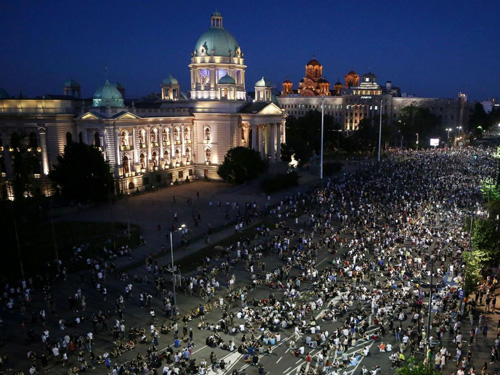Belgrade
Seated protesters have filled streets across Serbia in a powerful display of discontent, hours after authorities banned gatherings of more than 10 people in response to two nights of violent skirmishes between police, far-right agitators and those protesting the government’s handling of the coronavirus crisis.
Thousands defied the ban to stage a “sit-in” in front of Serbia’s parliament complex, which protesters had stormed two nights earlier, with similar demonstrations also taking place peacefully in Novi Sad, Nis, and many other cities.
The unrest started on Tuesday evening after president Aleksandar Vucic said further lockdown measures would likely be reimposed due to rising coronavirus cases and full hospitals, particularly in Belgrade, sparking furious clashes the president described as the country’s most brutal political violence in years.
Mr Vucic – whose populist right-wing Serbian Progressive Party retained power in a controversial and partially boycotted election on 22 June – backed down from his plans to impose a curfew, instead issuing the ban on gatherings, largely viewed as an attempt to criminalise the mass protests.
While the violence seen on the two nights prior – in which dozens of citizens and police were injured – was largely discontinued on Thursday, there were reports of more minor clashes between demonstrators and nationalist groups towards the end of the night, and two journalists were attacked.
Famed television presenter Ivan Ivanovic tweeted an image of a digital camera covered in blood, captioned “my reporter”, with some local media outlets reporting that projectiles had been thrown at his crew, one of whom suffered a broken nose.
Vojislav Milovancevic, a journalist with Nova, required medical treatment. He reported being approached by “a group of guys with hoods”, telling his colleagues: “One of them, when he saw me filming, ran towards me and asked ‘what are you filming’.
“I told him I was a journalist and then he hit me, I think with a knuckle-duster. He swung twice and the third time he hit me in the back of the head and bled my head.”
There were reports of at least two other journalists being confronted during the demonstrations and accused of lying. Mistrust of the media is high in Serbia amid alleged collusion between press and government, and the demonisation of critical outlets.
In May, Reporters Without Borders warned: “After six years under the leadership of Aleksandar Vucic … Serbia has become a country where it is often dangerous to be a journalist and where fake news is gaining in visibility and popularity at an alarming rate.”
Many protesters wore white T-shirts bearing the words “Sit Down, Don’t Be Set Up” — referring to widespread claims that the violence the previous nights was staged by groups close to the authorities to smear the opposition groups’ image.—AFP










